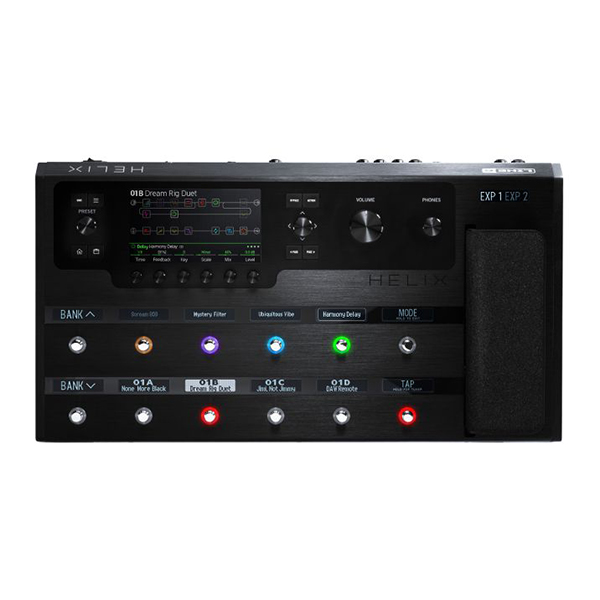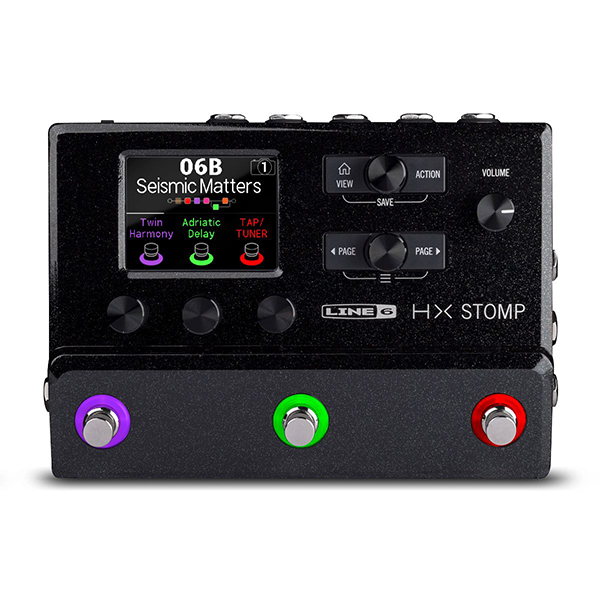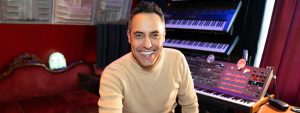Jeff Schroeder Shares His Helix Shoegaze Tones
by Jeff Schroeder
The analog versus digital debate will most likely continue well into the future—but one thing that cannot be argued is the flexibility that digital modeling platforms such as Helix provide for musicians in the 21st century.
When people ask me why I’m so attracted to Helix as the core of both my recording and live setup, I often say that beyond the great sounds it produces, written within the code of the software are not only various tone-shaping devices, but also a historical overview of the most important and utilized amps, speakers, and effects from the 1950s to the present.
As a working musician who travels to various parts of the world to perform and record, I’m able to carry this history either on my laptop using the Helix Native plugin, or in my suitcase with a device as compact as HX Stomp. Whether on stage or in the studio, I’m no longer limited to the physical amps and other gear I have on hand. I can let my ears and mind lead the way in the creative process.
I started playing guitar in the mid-’80s and was very influenced by the hard rock and heavy metal guitar hero culture of the time. Steve Vai, Joe Satriani, and Yngwie Malmsteen were some of the most significant figures in my early development. What they were playing was much too sophisticated and technically difficult for me at the time, but I did a lot of listening and absorbing. During high school, through friends, I was also introduced to a lot of music that fell somewhat outside the guitar magazine culture that was feeding me most of what I was listening to.
As the ’80s ended and the early ’90s began, I repeatedly heard about these new “shoegaze” bands coming out of the UK. They earned this moniker because they allegedly spent entire performances staring at their effect pedals on the ground, which was a valid perspective to some extent. I soon began picking up albums by bands like My Bloody Valentine, Ride, Swervedriver, Slowdive, and Lush. I heard how these bands used effects to add size, depth, and a feeling of transcendence to their sound, and quickly became a devoted disciple of this school of guitar playing, going so far as getting my first credit card so I could order a Japanese reissue Jazzmaster from my local music store.
Pre-internet, it was sometimes difficult to decipher exactly how these bands were creating these sounds and textures. What types of pedals were they using? Was there studio rack gear processing taking place? It was all a bit of a mystery and I spent almost any money I had at the time buying gear in my search for these sounds. What I arrived at over time was a very cobbled together rig that consisted of both pedals and rackmount effects all run into the front of clean amp. When it all worked, it sounded great, but it was fairly limited in terms of getting higher-gain-based tones. Now, with Helix, I’m able to traverse time and move between the mid-’80s, early ’90s, and into the present with touch of a button.
Interestingly, somewhere between heavy metal and shoegaze is where I still reside stylistically today. In this post, I’m going to focus on some of my favorite shoegaze-style sounds that I’ve created using Helix. I’ve purposely chosen fairly straightforward signal paths and routing to demonstrate that it’s not necessary to overly complicate the process.
EXAMPLE 1

Example 1 is a clean sound I created based upon the Jazz Rivet 120 amp and cabinet model. To emulate its real-world counterpart, the Roland JC-120, I’ve included the 70s Chorus in “Classic” stereo mode right after the amp. You will also notice I added an LA Studio Comp compressor and a Noise Gate after the chorus block. I find these helpful in keeping the direct guitar clear and present when surrounded by a wash of delay and reverb. The delay is the Vintage Digital because to my ears it has the sound of this period. The reverb is the Searchlights, which adds a beautiful modulation to the decay, imparting a nice internal movement to the sound.
The key to achieving the wash of sound we’re looking for is getting the right mix balances on the delay and reverb. Here, the settings are below the 50% mark. However, sometimes you’ll want to have more effected signal than direct signal. As the audio example shows, you can get away with playing simple arpeggiated chords or single-note lines but still create a large sound with lot of layers and depth. As a player, you want to leave enough space in the notes so you can react to what is happening with chorus, delay, and reverb.
EXAMPLE 2

Example 2 is a sound that harkens back to, but it is not an exact replication of, the “glide guitar” sound made famous by My Bloody Valentine. To remain in the spirit of the UK, the preset is based upon the Essex A30 amp and cab model. This midrange-focused sound works well and will help you avoid getting lost in the mix because it doesn’t take up as much sonic space as you might think. That being said, any light- to medium-overdriven sound will work well.
The key to getting this sound is choosing the right type of reverb, setting a long decay time, and setting the mix level on the reverb to where it feels like the sound is slightly fading in. The Glitz reverb is a wonderful choice for this sound. If you download the preset, you’ll notice the mix level is at 58%. What that means is that there is more effected signal than dry signal. This is why the sound fades in and appears to get louder as it decays. At the end of the chain is a stereo Ping Pong delay to add even more spread to the sound. You’ll also see that I placed a Minotaur drive block at beginning. Kick this on when playing single-note lines. Oh yes, if you have a whammy bar, please utilize it.
EXAMPLE 3

Example 3 takes its inspiration from unsung experimental shoegaze guitar hero Brad Laner, from the LA-based band Medicine. Of all the bands that fall within the shoegaze rubric, Medicine is by far my favorite, even though they existed very much under the radar in the ’90s. I think this was mostly because they weren’t really a shoegaze band in the traditional sense. If anything, they were a very noisy experimental pop band.
Semantics aside, Laner achieved his over-the-top sound by using a 4-track cassette recorder as his distortion pedal. To add to the chaos, he ran all of his delays and reverbs before the 4-track, in essence frying and radically distorting all the repeats and trails. The preset is one I use in my non-Smashing Pumpkins band Night Dreamer. It comes from a song off our Treasure EP called “The Taste.”
To achieve a Laner-esque tone, I purposely didn’t use any amp in the signal chain. Instead, I am running two distortion pedals—Industrial Fuzz and Teemah!—one after the other as if I was going direct into a recording console. This creates a very square wave, synth-type sound. The sound I use in the audio is from Snapshot 3, which is my main lead sound for the song. Be forewarned, the sound is very noisy and out-of-control. Post the two distortions pedals, I’m running two delays—Reverse and Ping-Pong. Finally, at the end of the chain is a little bit of Ganymede reverb. Like in Example 1, this is a very reactive preset. You’ll want to respond to what the sound is giving back to you.
Hopefully, what these examples will highlight is that it’s about utilizing the right types of effects and ambiences to achieve those spacey, washed-out sounds shoegaze bands are known for.

Jeff Schroeder is a musician based in Los Angeles. He currently plays guitar in the Smashing Pumpkins and Night Dreamer. Besides guitar, Jeff is obsessed with coffee and 20th century experimental literature.
Learn more about Helix.
Primary Photo: Travis Shinn
Related posts
Leave a Reply
You must be logged in to post a comment.
By submitting your details you are giving Yamaha Guitar Group informed consent to send you a video series on the Line 6 HX Stomp. We will only send you relevant information. We will never sell your information to any third parties. You can, of course, unsubscribe at any time. View our full privacy policy







The 3rd example is very reminiscent of C64 music. The first thing I thought of when I heard it was the game Rambo. Very cool.
Thanks a lot for these presets, directly moved to my favorite folder ! Thanks Jeff and congrats for Night Dreamer, love it.
Fantastic tones , really shows what creativity can be achieved with the helix !